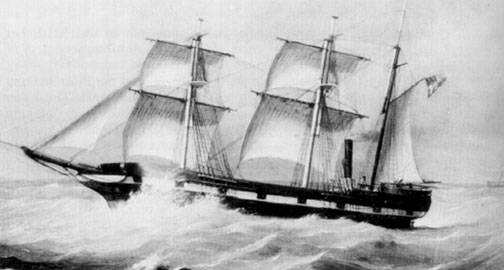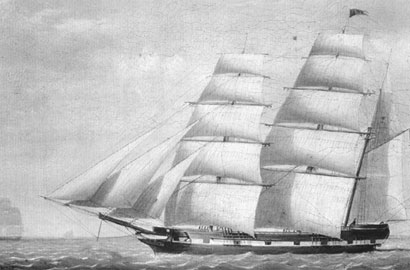We are so excited to feature Justin Ruhge on our Adventure Blog. Mr. Ruhge is an incredible historian, who has written several wonderful books about Santa Barbara’s maritime tragedies, historical structures, and pioneer families. If you want to hear some amazing tales of central California, pick up one of Mr. Ruhge’s books or check one out at the library. I sincerely hope this is the first of many contributions he will share with our readers. Please enjoy.
USS Edith
Shipwrecked August 24, 1849
The Edith was one of many famous ships built by the renowned Boston merchant, Robert B. Forbes. It was a steam bark commissioned in 1844 by Forbes to use in the opium trade between British India and China. She was one of the first American ships to be built with a steam engine and a propeller drive designed by the famous shipbuilder, John Ericsson. The ship used coal for fuel when underway with steam and, when under sail, the propeller could be raised out of the water to reduce drag. The Edith also carried the new rigging used by Forbes with which a full set of sails could be added by means of an extendable mast.
After a four-year stint in the Opium trade in India beginning in 1845, the Edith returned to New York where she was sold to the War Department for use in the Mexican American War that was raging at that time. The ship was used to move Army supplies to Mexico and then to the Army of Occupation in California.
The Edith was transferred from the War Department to the Navy under congressional legislation on March 3, 1849 and turned over to Commodore Thomas ap Catesby Jones, Commander-in-Chief of the Pacific Squadron at San Francisco thus becoming a naval ship.
The Edith departed New York on November 9, 1848 and arrived in San Francisco on March 21, 1849. She made the passage in 110 running days of which she steamed fifteen. Her cargo consisted of Quarter Master stores, principally clothing.
The U.S.S. Edith is listed as a steam screw, 120 feet long, 32 feet beam and 400 tons displacement. The U.S.S. Edith was the second steamship to arrive in San Francisco, having been preceded by the California in February.
The ship was used by the Army for a number of tasks after unloading the Army supplies brought from the East Coast including trips to areas around California and down the coast to Mazatlan in Mexico
The Edith’s arrival brought with it the news that the Congress had adjourned without organizing a territorial government in California. All that the Congress had done was to pass laws for distributing mail and collecting revenue taxes in California (Not surprising).
With this late but disappointing news, the Army decided on June 3, 1849 to convene a constitutional convention in Monterey for the purpose of forming a government in California. Election of delegates took place on August 1, 1849. Delegates were to assemble at Monterey on September 1, 1849. The Edith was dispatched in mid-August to San Diego to pick up the delegates between there and Monterey. She had sailed this route a number of times on Army business before this trip south but this particular trip was different.

Unfortunately, she had run into a fog from San Francisco, and could not take any observation. On the second day out the Edith’s commander, Lt. McCormick, believed he was passing Point Conception. He changed course to head east down the Santa Barbara Channel, and in a very little while had his fine craft high up on land at high tide instead, where she proved a total loss, none to the regret of the local rancheros, who were all soon wearing Uncle Sam’s naval uniforms and making use of the fine bedding and furniture of the wreck. One could walk around the vessel at low tide. Nearly everything had been landed and the beach was piled high with the best of stores, canned goods, champagne and eatables of the very best, and of all kinds. These goods could not be hauled away, and everyone was welcome to what they wanted. The ship was left as a total loss.
The location of the wreck was well to the north of Point Concepcion on a broad sandy beach, and in the tide line at the mouth of San Antonio Creek on what is today the Vandenberg AFB. This area was used during World War II for army training at Camp Cooke.
Despite the loss of this historic ship, the delegates did arrive at Monterey, although history does not tell us how. Perhaps the brig Fremont was sent in the place of the Edith, after the Fremont returned from its trip to the north where it was used to transport those delegates to the convention. A State Constitution was drawn up and signed and the Convention ended on October 13, 1849. The first state legislature was convened at San Jose on December 15, 1849.
Major Garrett, who was left to watch after the Edith, was the original designer of the State Seal for which he was supposed to receive $1,000. The Edith is one of the ships shown in the Seal.
Captain William G. Dana, owner and Grande of the Nipomo Mexican Land Grant, and a distant cousin of Richard Henry Dana, obtained the salvage contract for the wreck from the Navy. The ship was stripped of its machinery and valuable equipment and the wooden hull left to the sea where it slowly sank out of sight at what is a remote location.
Years after the wreck was long forgotten, the owner and developer of the Point Sal Landing north of the wreck site about six miles, Mr. Charles H. Clark, traveled to the site in 1876 when it was exposed by the surf at a particularly low tide. He reported that the boiler, some of the machinery, piles of cannon balls and the brass ten-pounder guns have at times been uncovered by the tide. The anchors are still there. Mr. Clark took out about ten tons of chain, which he sold for old iron. The author has located no other references to the wreck so it is not known if other artifacts have been removed since 1876.
The site has since been surveyed by a California State Transportation (Caltrans) archeologist using a magnetometer. The wreck was located buried under the sand in the surf line north of San Antonio Creek.
In 2009 the writer used Google Map aerial video images to locate the wreck at the location stated by the Navy Board of Inquiry in 1850, at latitude 34 degrees, 47 minutes and 30 seconds. The hull is still visible at low tides after 161 years of battering by the surf!
Reference: “Maritime Tragedies on the Santa Barbara Channel” by Justin M. Ruhge, 2000.
The Drawings of the U.S.S Edith are two that exist at the U. S. Naval Academy Museum at Annapolis, Maryland.
